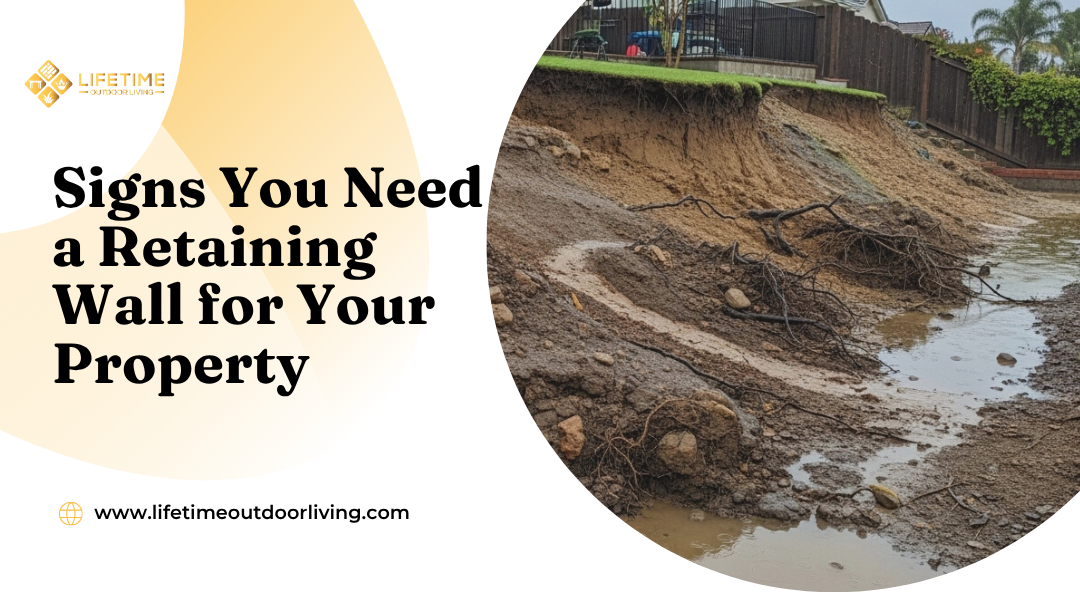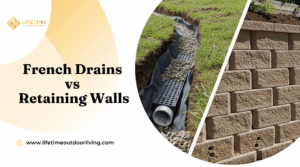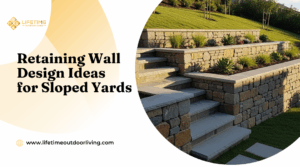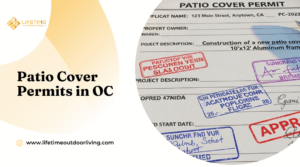A retaining wall is a practical solution for managing soil erosion and stabilizing uneven or sloped landscapes. If you notice visible soil movement, pooling water, or cracks in your property, these are clear signs that your landscape might be at risk and could benefit from a retaining wall. Lifetime Outdoor Living, a trusted paving contractor in Laguna Beach, California, specializes in designing and installing retaining walls that protect and enhance outdoor spaces.
Many homeowners overlook subtle warning signs until damage becomes costly to repair. Detecting problems early can prevent further soil displacement and foundation issues. This article highlights seven common indicators that a retaining wall might be necessary, helping property owners make informed decisions about their landscape stability.
Lifetime Outdoor Living brings extensive experience to every project, ensuring that retaining walls are both functional and visually appealing. Their expert team combines quality craftsmanship with tailored designs to suit the specific needs of Orange County homeowners facing landscape challenges.
Why Retaining Walls Matter In Landscape Design
Retaining walls provide crucial support in managing soil and water on uneven ground. They help prevent erosion, protect property, and enhance outdoor spaces by creating usable, level areas.
What Is A Retaining Wall And Its Function
A retaining wall is a constructed barrier designed to hold back soil and prevent it from sliding or eroding. It stabilizes slopes and maintains different ground levels, especially where natural terrain creates significant height differences.
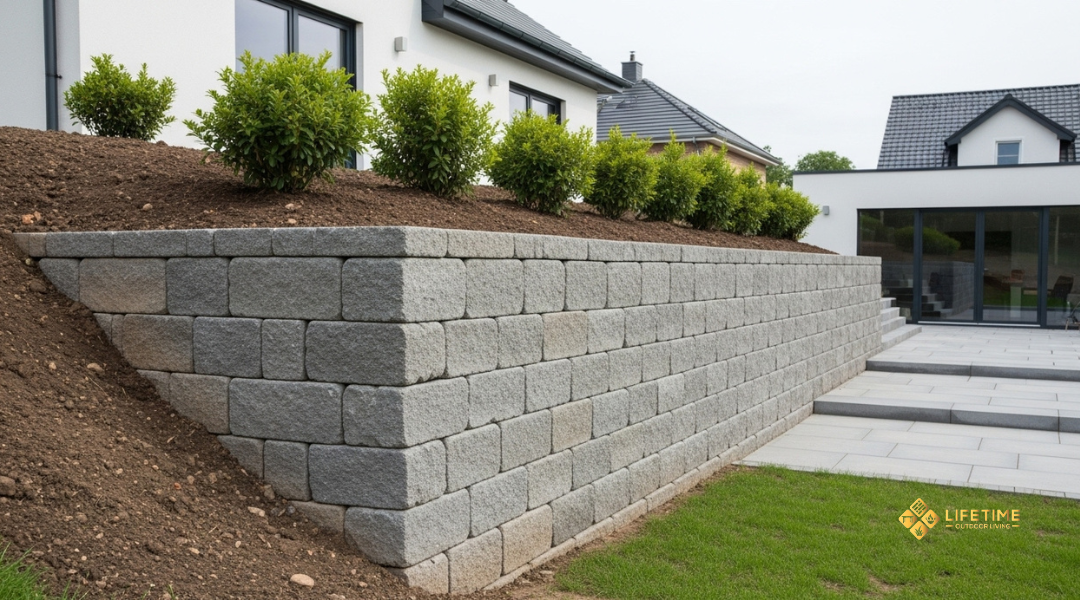
The main functions include soil retention, water runoff management, and protection against landslides or erosion. Retaining walls can be made from materials like concrete, stone, or timber, chosen based on strength needs and aesthetic preferences.
Benefits Of Retaining Walls In Sloped Or Eroding Landscapes
Retaining walls reduce soil erosion by holding soil in place and controlling water flow. They create flat, usable spaces for planting, patios, or walkways on sloped properties.
By managing slope stability, these walls prevent damage to foundations, landscaping, and outdoor features. Retaining walls also improve drainage, reducing water pooling and minimizing risk of landslides in heavy rain.
The Unique Terrain Challenges In Laguna Beach, CA
Laguna Beach’s coastal hills have steep slopes and clay-heavy soils prone to erosion. Seasonal rains cause rapid runoff, increasing the risk of soil displacement without proper support.
Seismic activity in the region also demands retaining walls that can withstand ground movement. Retaining walls designed for Laguna Beach must combine durability, drainage, and aesthetic integration with natural surroundings.
Sign #1: Noticeable Soil Erosion After Rainfall
Soil erosion often appears as displaced dirt or exposed roots after heavy rain. This issue can affect the stability of the yard and potentially damage nearby structures if left unaddressed.
Why Erosion Is Dangerous To Your Home And Yard
Erosion removes the topsoil that supports plants and lawn roots, reducing their ability to hold the ground together. Gradual soil loss can lead to uneven surfaces, creating trip hazards and damaging garden beds.
Near structures, erosion increases the risk of foundation problems by washing away soil that supports footing. Water pooling from poor drainage can also cause basement flooding or wall cracks.
Uncontrolled erosion further allows sediment to enter local drainage systems, contributing to water pollution issues in Laguna Beach neighborhoods.
How A Retaining Wall Controls Runoff And Stabilizes Soil
A retaining wall acts as a physical barrier that holds soil in place on slopes or uneven terrain. It slows down water runoff, reducing soil displacement caused by rain.
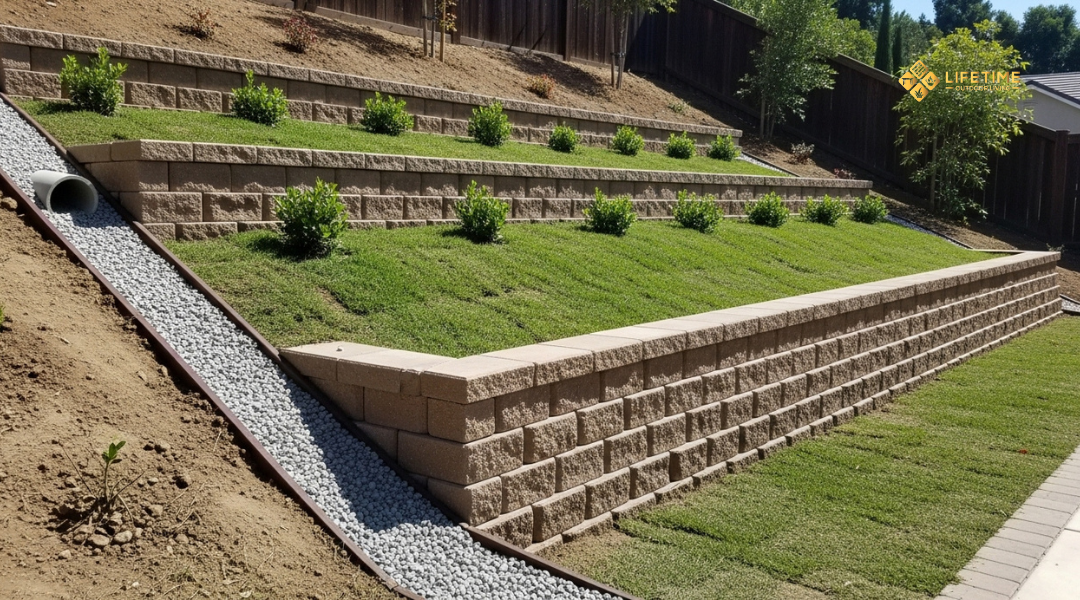
By directing runoff to designated drainage areas, retaining walls help prevent water accumulation that leads to erosion. The structure supports plant roots, improving their ability to stabilize soil naturally.
Properly installed retaining walls can extend the lifespan of landscaping elements and protect nearby structures from erosion-related damage.
Sign #2: Cracks In Your Driveway, Walkways, Or Patio
Cracks in hardscape surfaces often indicate movement or instability in the soil underneath. These fractures can worsen over time, potentially leading to uneven or unsafe surfaces. Addressing the root cause of the cracks is critical to protect the integrity of these outdoor structures.
How Ground Movement Affects Hardscapes
Soil shifting occurs due to moisture changes, erosion, or natural settling. When the soil beneath paving surfaces moves, it creates pressure that causes concrete, asphalt, or stone to crack. Expansion and contraction from temperature changes also contribute to these breaks.
Different soil types behave differently; clay soils swell with water and shrink when dry, increasing the risk of movement. Loose or poorly compacted soil provides inadequate support, leading to sinking or heaving. Cracks are often one of the first visible signs that ground movement is damaging hardscape stability.
When A Retaining Wall Can Prevent Further Damage
Retaining walls stabilize the soil by holding back slopes and preventing erosion. They help control water runoff, reducing soil saturation that causes ground shifts under driveways and patios. By maintaining a firm soil base, retaining walls limit the stress that leads to cracking.
Installing an appropriate retaining wall near cracked hardscapes can redistribute soil pressure evenly. This prevents further movement and helps preserve the surface. For properties on uneven terrain or where erosion is evident, a retaining wall is a practical investment to protect outdoor living spaces.
Sign #3: Sinking Or Uneven Ground In Your Yard
Uneven or sinking ground can create hazards and reduce the usable area of a yard. This issue often signals soil movement beneath the surface, which can worsen if not addressed. Understanding the causes and the role of retaining walls in stabilization is essential.
Causes Of Soil Shifting On Sloped Properties
Soil shifts on slopes due to several factors. Water runoff from rain or irrigation saturates soil, reducing its stability. Over time, the soil loses cohesion and begins to slide downward.
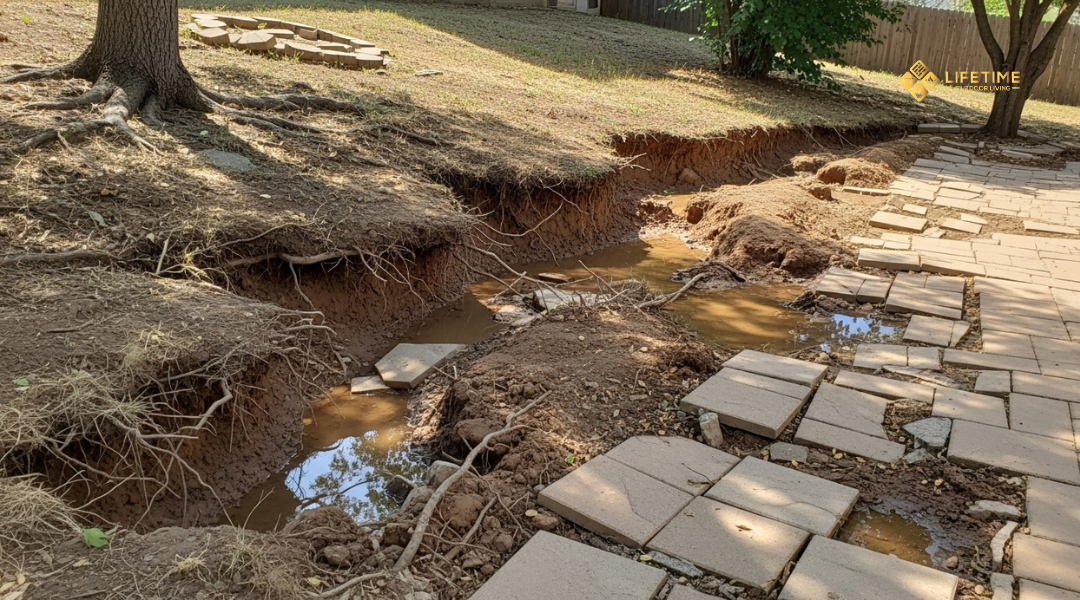
Poor drainage exacerbates this process by pooling water in weak spots. Tree roots and heavy foot traffic can also disrupt soil structure. In some cases, natural soil composition, like clay, absorbs water and expands, causing ground to sink unevenly.
These shifts cause cracks in patios, walkways, and even house foundations. Identifying soil movement early can prevent damage and costly repairs.
How Retaining Walls Help Reclaim Stability And Useable Space
Retaining walls provide structural support to hold back soil on an incline. They create a firm barrier that reduces downward soil pressure. This prevents further shifting and sinking.
These walls allow property owners to level sloped areas, thereby increasing usable yard space. They can also improve drainage by directing water away from vulnerable soil. Materials like concrete, stone, or treated timber make walls durable against erosion forces.
Properly designed retaining walls distribute soil weight evenly. They protect landscaping and reduce hazards caused by uneven ground. Adding a retaining wall is often a practical solution to stabilize slopes and preserve outdoor space.
Sign #4: Pooling Water Or Poor Drainage
Pooling water and poor drainage can damage both the landscape and any structures nearby. Addressing these issues early can prevent soil erosion, plant damage, and structural failures. Effective control of water flow is crucial for maintaining landscape stability and longevity.
Why Drainage Is A Major Red Flag
Standing water indicates that rainwater or irrigation isn’t draining properly. This often results from soil compaction, improper grading, or blockage in existing drainage paths. Poor drainage increases the risk of soil erosion under patios, walkways, and around foundations.
Excess moisture can weaken soil strength, causing slopes to shift or settle unevenly. This destabilizes the landscape and may lead to costly repairs. Persistent water pooling also encourages weed growth and can damage plants by suffocating roots.
Integrating Drainage Solutions Into A Retaining Wall System
Retaining walls can include drainage features like perforated pipes, gravel backfill, and weep holes to control water movement. These elements direct excess water away from the wall and prevent pressure buildup behind it.
Proper installation requires grading the soil to slope away from the wall. Combining these features ensures water drains efficiently without compromising the wall’s structural integrity. Choosing the right drainage solution depends on soil type, slope, and local rainfall patterns.
Sign #5: Exposed Tree Roots Or Washed-Out Landscaping
Exposed roots and washed-out soil indicate active erosion problems in a landscape. These issues can weaken plant stability and damage surrounding hardscape elements.
How Root Exposure Signals Erosion
When soil washes away, tree roots begin to surface. This exposure reduces root protection from moisture loss and physical damage.
Exposed roots can cause trees to become unstable, increasing the risk of falling during storms. It also affects the tree’s ability to absorb nutrients and water, harming its health.
Soil erosion around landscaping beds often causes washed-out borders and uneven ground. These changes can destabilize plants and reduce landscape aesthetics.
How A Retaining Wall Can Protect Trees And Plants
A properly designed retaining wall holds back soil and prevents further erosion. It maintains the integrity of planting beds, preserving soil depth around roots.
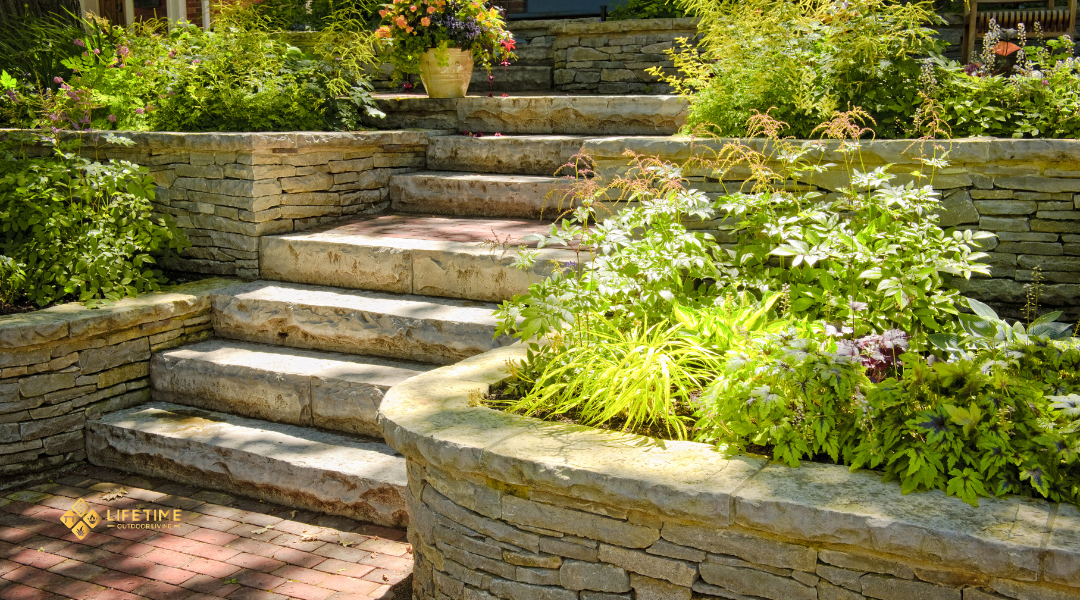
Retaining walls reduce water runoff speed, minimizing soil loss near trees and shrubs. They create stable terraces that improve water distribution and planting conditions.
This barrier supports root systems by keeping soil tight and protected. Proper drainage behind the wall also prevents water buildup that can harm roots.
Sign #6: A Sloped Yard You Can’t Use Safely
A steep yard limits functional outdoor activities and complicates landscaping efforts. Addressing slope challenges through structural solutions can enhance the usability and enjoyment of the space significantly.
Functional Benefits: Terracing, Seating, And Usable Outdoor Space
Retaining walls create flat, stable terraces that make slopes safer and more accessible. These leveled areas can be used for patios, play zones, or garden beds without the risk of slips or erosion.
Walls can also support built-in seating, turning unusable slopes into comfortable outdoor living areas. With secure footing, families and guests can enjoy the yard without concerns about uneven ground.
This setup improves drainage control, reducing soil runoff that makes slopes hazardous. Properly engineered retaining walls enable practical use of previously challenging land with minimal maintenance.
Aesthetic Enhancements: Landscape Architecture Possibilities
Retaining walls offer strong visual definition, breaking up a steep slope into layered, attractive sections. This approach adds depth and structure, increasing landscape appeal.
They provide a foundation for planting beds, allowing for creative arrangements of trees, shrubs, and flowers at various heights. This diversity enhances natural beauty and visual interest.
Materials like natural stone or concrete can be chosen to match the home’s style, adding architectural cohesion. The result is a unified, polished landscape that blends function with visual impact.
Sign #7: Signs Of Foundation Movement Or Cracking
Foundation issues often show as visible cracks or shifts in the structure around a home. These signs indicate pressure from soil or water buildup, which can lead to costly damage if left unaddressed.
How Landscape Pressure Affects Home Foundations
Soil movement from water saturation or erosion exerts uneven pressure on foundations. This pressure can cause walls to crack, bow, or shift, especially in areas with sloped landscapes or poor drainage.
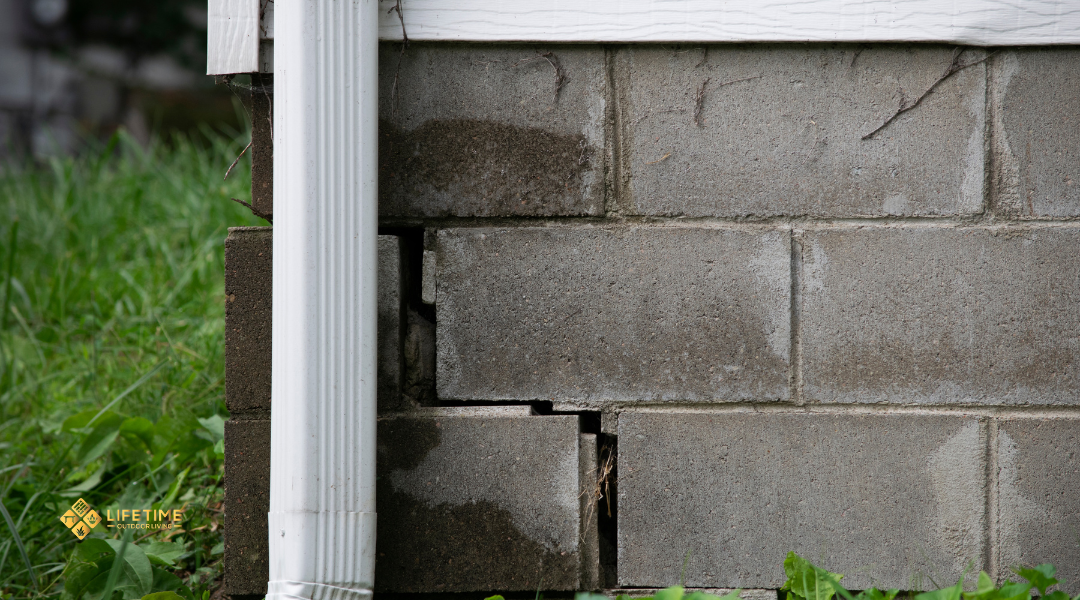
Heavy rainfall or irrigation that is not properly managed increases soil volume and weight against the foundation. This pushes inward and may lead to stair-step cracks in brickwork or gaps around doors and windows, signaling structural stress.
Without addressing landscape-induced pressure, small foundation problems often worsen. Catching these signs early is crucial to prevent structural damage.
Using Retaining Walls To Prevent Costly Structural Repairs
Retaining walls stabilize soil and reduce lateral pressure on foundations, making them a practical solution in hilly or unstable areas. By holding back soil, they prevent downhill soil movement and water pooling near the home.
A properly designed retaining wall includes drainage features like weep holes or gravel backfill to direct water away from the foundation. This limits water pressure buildup and soil expansion.
Lifetime Outdoor Living often recommends retaining walls to protect foundations while enhancing property aesthetics. Investing in these structures can reduce repair expenses and maintain the home’s structural integrity over time.
Choosing The Right Type Of Retaining Wall For Your Property
Different retaining walls serve varied purposes depending on soil conditions, slope steepness, and aesthetic preferences. The choice involves understanding structural differences, material benefits, and customization possibilities to suit Laguna Beach landscapes.
Gravity Walls Vs. Reinforced Walls Vs. Modular Block Walls
Gravity walls rely on their own weight to hold back soil. They are best for low to moderate height applications, typically under 3 feet. Their thick mass and heavy materials provide stability without extra support.
Reinforced walls include internal supports like steel bars or geogrids. These are essential for taller walls or slopes needing additional strength. They distribute pressure and prevent soil shifting over time.
Modular block walls consist of interlocking concrete blocks designed for easy assembly and drainage. They offer flexibility in design and are suitable for various heights. Their drainage features reduce hydrostatic pressure behind the wall.
Materials: Natural Stone, Concrete Block, Timber
Natural stone is durable and visually appealing, blending well with outdoor environments. It requires skilled installation but offers long-term resilience and minimal maintenance.
Concrete block walls provide uniformity and strength. They come in various shapes and colors for creative designs. Concrete is cost-effective and withstands weathering and pressure.
Timber walls offer a warm, natural look but have a shorter lifespan. They are best for temporary or low-height walls. Treatment is necessary to resist rot and insect damage in humid climates.
Custom Design Options From Lifetime Outdoor Living
Lifetime Outdoor Living offers tailored retaining wall solutions that match specific slope requirements and style preferences. They integrate soil analysis and site grading into the design process to enhance wall durability.
Custom options include mixed materials and finishes, lighting integration, and built-in planters or seating. Their designs consider Laguna Beach’s coastal climate and local regulations for structural safety.
Why Homeowners In Laguna Beach Trust Lifetime Outdoor Living
Lifetime Outdoor Living combines a deep understanding of local terrain with comprehensive services and a strong focus on quality. Their expertise ensures durable, functional outdoor solutions tailored to the unique challenges of Laguna Beach properties.
Local Knowledge Of Coastal And Sloped Terrain
Laguna Beach’s coastal environment and steep landscapes present specific challenges such as erosion, soil instability, and moisture damage. Lifetime Outdoor Living’s team has extensive experience working with these conditions, ensuring retaining walls and paving solutions are designed to resist shifting soil and salt exposure.
They perform detailed site assessments to determine drainage patterns and soil behavior on hillsides. This expertise helps in selecting materials and construction techniques that withstand the local climate and terrain, reducing future maintenance and repair needs.
Full-Service Solutions: Paving, Walls, Drainage, And More
Lifetime Outdoor Living offers integrated outdoor construction services, covering everything from paving patios to building retaining walls and installing drainage systems. This approach minimizes coordination issues and ensures that all aspects of landscape stability and aesthetics work together.
Clients benefit from a single point of contact managing the entire project. Their experience allows them to address interconnected issues like water runoff control and soil retention, providing long-lasting results without the need for multiple contractors.
Commitment To Quality Craftsmanship And Customer Satisfaction
The company prioritizes durability and precision in every project, using premium materials suited to Laguna Beach’s environment. Skilled craftsmen follow best practices and local building codes to ensure structural integrity and visual appeal.
Customer communication is key throughout the process. Lifetime Outdoor Living maintains transparency on timelines and costs, leading to high satisfaction rates among homeowners who want dependable service and clear project management.

